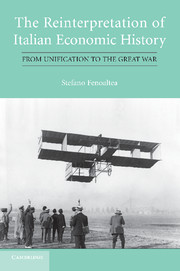Book contents
- Frontmatter
- Contents
- List of Tables
- List of Figures
- Acknowledgments
- Preface
- Introduction
- 1 The Time Series and the Interpretations
- 1A The Measurement of Production Movements
- 2 The Investment Cycle
- 3 The Consumption Cycle and the “Crisis” of the 1880s
- 4 Protection and Migration
- 5 Railways
- 6 North and South
- 6A North and South: A Sectoral Analysis
- 7 The State of Play
- APPENDICES: TARIFFS, TRADE, MIGRATION, AND GROWTH
- Appendix 1 Tariffs and Market Prices
- Appendix 2 The Ricardian Model of Trade
- Appendix 3 Migration and Relative Mobility
- Appendix 4 The Ricardian Model of Growth
- References
- Index
Appendix 1 - Tariffs and Market Prices
Published online by Cambridge University Press: 05 March 2012
- Frontmatter
- Contents
- List of Tables
- List of Figures
- Acknowledgments
- Preface
- Introduction
- 1 The Time Series and the Interpretations
- 1A The Measurement of Production Movements
- 2 The Investment Cycle
- 3 The Consumption Cycle and the “Crisis” of the 1880s
- 4 Protection and Migration
- 5 Railways
- 6 North and South
- 6A North and South: A Sectoral Analysis
- 7 The State of Play
- APPENDICES: TARIFFS, TRADE, MIGRATION, AND GROWTH
- Appendix 1 Tariffs and Market Prices
- Appendix 2 The Ricardian Model of Trade
- Appendix 3 Migration and Relative Mobility
- Appendix 4 The Ricardian Model of Growth
- References
- Index
Summary
The possible cases
The possible effect of a tariff on the market price of the protected good is illustrated in Figure A1.01. From one graph to the other domestic demand, the world price, and the tariff are kept constant, and the assumption of a competitive domestic market is maintained; domestic supply varies. At the world price foreign producers can provide, and foreign consumers absorb, “unlimited” quantities of the good in question: the home country is assumed small, in the sense that its own sales and purchases cannot materially affect world-market equilibrium.
In the first case domestic supply and demand intersect at a price above the world price augmented by the entire tariff: the tariff limits imports, but does not eliminate them. In this case the domestic market price exceeds the world price by the full amount of the tariff: foreign supply allows domestic consumers to purchase goods without paying more than the world price plus the tariff, and at that (tariff-inclusive) price domestic demand exceeds domestic supply.
In the second case domestic supply and demand intersect at a price that exceeds the world price, but by less than the tariff. The domestic price is generated directly by that intersection: the tariff eliminates the imports that would otherwise take place, but precisely because it is thus prohibitive the domestic market price exceeds the world price by only part of the tariff itself.
In the third case domestic supply and demand intersect at a price lower even than the world price.
- Type
- Chapter
- Information
- The Reinterpretation of Italian Economic HistoryFrom Unification to the Great War, pp. 249 - 251Publisher: Cambridge University PressPrint publication year: 2011

